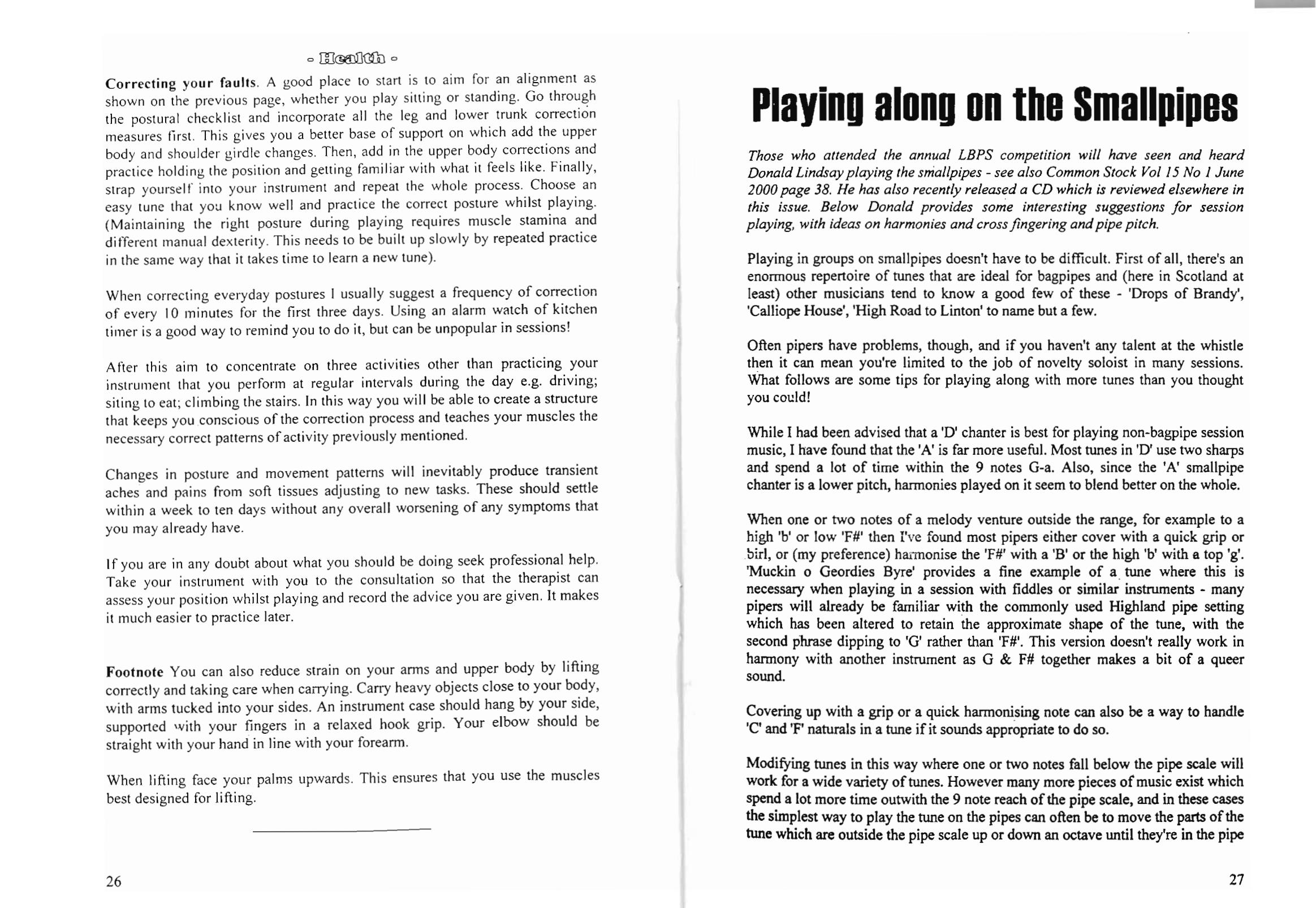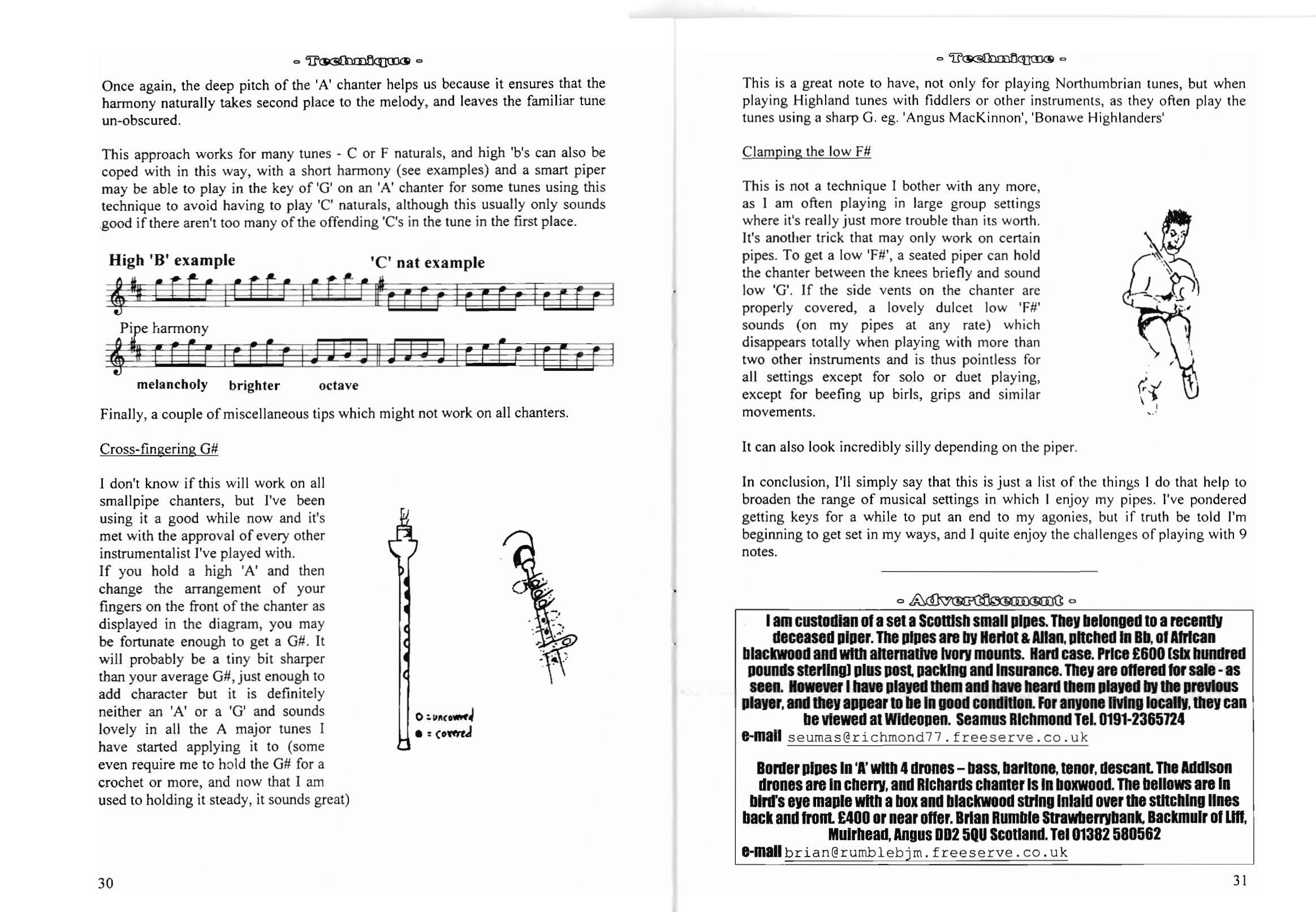Playing Along on the Smallpipes



Those who attended the annual LBPS competition will have seen and heard Donald Lindsay playing the smallpipes - see also Common Stock Vol 15 No 1 June 2000 page 38. He has also recently released a CD which is reviewed elsewhere in this issue. Below Donald provides some interesting suggestions for session playing, with ideas on harmonies and cross fingering and pipe pitch.
Playing in groups on smallpipes doesn't have to be difficult. First of all, there's an enormous repertoire of tunes that are ideal for bagpipes and (here in Scotland at least) other musicians tend to know a good few of these - 'Drops of Brandy', 'Calliope House', 'High Road to Linton' to name but a few.
Often pipers have problems, though, and if you haven't any talent at the whistle then it can mean you're limited to the job of novelty soloist in many sessions. What follows are some tips for playing along with more tunes than you thought you could!
While I had been advised that a 'D' chanter is best for playing non-bagpipe session music, I have found that the 'A' is far more useful. Most tunes in 'D' use two sharps and spend a lot of time within the 9 notes G-a. Also, since the 'A' smallpipe chanter is a lower pitch, harmonies played on it seem to blend better on the whole.
When one or two notes of a melody venture outside the range, for example to a high 'b' or low 'F#' then I've found most pipers either cover with a quick grip or birl, or (my preference) harmonise the 'F#' with a 'B' or the high 'b' with a top 'g'. 'Muckin o Geordies Byre' provides a fine example of a tune where this is necessary when playing in a session with fiddles or similar instruments - many pipers will already be familiar with the commonly used Highland pipe setting which has been altered to retain the approximate shape of the tune, with the second phrase dipping to 'G' rather than 'F#'. This version doesn't really work in harmony with another instrument as G & F# together makes a bit of a queer sound.
Covering up with a grip or a quick harmonising note can also be a way to handle 'C' and 'F' naturals in a tune if it sounds appropriate to do so.
Modifying tunes in this way where one or two notes fall below the pipe scale will work for a wide variety of tunes. However many more pieces of music exist which spend a lot more time outwith the 9 note reach of the pipe scale, and in these cases the simplest way to play the tune on the pipes can often be to move the parts of the tune which are outside the pipe scale up or down an octave until they're in the pipe
scale - ie. low 'D' becomes 'd' in the middle of the pipe scale, low 'Esbecomes 'e' on the top hand of the pipe scale and so on.
This works for many tunes such as this version of the Harvest Home Hornpipe (orginal melody and pipe version illustrated below). Here, the fact that the A chanter is pitched an octave below works in our favour, hiding the seam between the bit we 'bent' upwards and the bit we play as it is written. It's hard to explain this, but I think you'll hear what 1 mean when you try playing this pipe version of the tune preferably in a duet with a fiddle or other instrument, although it sounds fine solo.
Harvest Home (Trad. Arr Donald Lindsay)
This is the real trick with 'bending' tunes to fit the pipes - hiding the 'seams'. With some tunes it's very difficult to cover over the seams, and the tune just ends up sounding like a disjointed mess.
Harmonising
This can be the most challenging option, but also the most rewarding because it's where the 'limitations' of pipes provide the inspiration to add something unique to the music.
A harmony for a tune doesn't need to sound like a tune in itself, in fact it'll usually sound a bit odd - try this harmony for 'The Soldier's Joy', another well-known tune. It could stand alone as a tune, but it wouldn't really be recognisable as 'The Soldier's Joy'. However, find yourself a fiddler, whistler or similar, get them to play the melody on the top line and you have a very colourful arrangement of an otherwise familiar tune.
Soldiers Joy Trad. Arr Donald Lindsay
Once again, the deep pitch of the 'A' chanter helps us because it ensures that the harmony naturally takes second place to the melody, and leaves the familiar tune un-obscured.
This approach works for many tunes - C or F naturals, and high 'b's can also be coped with in this way, with a short harmony (see examples) and a smart piper may be able to play in the key of 'G' on an 'A' chanter for some tunes using this technique to avoid having to play 'C naturals, although this usually only sounds good if there aren't too many of the offending 'C's in the tune in the first place.
Finally, a couple of miscellaneous tips which might not work on all chanters.
Cross-fingering G#
I don't know if this will work on all smallpipe chanters, but I've been using it a good while now and it's met with the approval of every other instrumentalist I've played with. If you hold a high 'A' and then change the arrangement of your fingers on the front of the chanter as displayed in the diagram, you may be fortunate enough to get a G#. It will probably be a tiny bit sharper than your average G#, just enough to add character but it is definitely neither an 'A' or a 'G' and sounds lovely in all the A major tunes I have started applying it to (some even require me to hold the G# for a crochet or more, and now that I am used to holding it steady, it sounds great.
This is a great note to have, not only for playing Northumbrian tunes, but when playing Highland tunes with fiddlers or other instruments, as they often play the tunes using a sharp G. eg. 'Angus MacKinnon', 'Bonawe Highlanders'
Clamping the low F#
This is not a technique I bother with any more, as I am often playing in large group settings where it's really just more trouble than its worth. It's another trick that may only work on certain pipes. To get a low 'F#', a seated piper can hold the chanter between the knees briefly and sound low 'G'. If the side vents on the chanter are properly covered, a lovely dulcet low 'F#' sounds (on my pipes at any rate) which disappears totally when playing with more than two other instruments and is thus pointless for all settings except for solo or duet playing, except for beefing up birls, grips and similar movements.
It can also look incredibly silly depending on the piper.
In conclusion, I'll simply say that this is just a list of the things 1 do that help to broaden the range of musical settings in which 1 enjoy my pipes. I've pondered getting keys for a while to put an end to my agonies, but if truth be told I'm beginning to get set in my ways, and I quite enjoy the challenges of playing with 9 notes.
